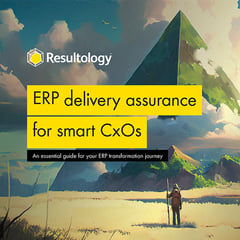On your way back from a meeting your colleague Paul complains of a bite wound he received from the CEO’s PA.
You don’t think anything of it, she can be a bit of a dragon!
The next day a couple of zombies drift into the office, you don’t hesitate and kill them with a few swift blows to the head.
You come to the horrifying realisation that a zombie apocalypse has overwhelmed the SAP programme, the threat level is catastrophic.
You hatch a plan.
Go to the Winchester have a pint.
And wait for this whole thing to blow over.

Before you head to the Winchester to wait it out, these are the 6 most disastrous threats for Business Managers on SAP projects out of the 77 failure points identified in our SAP Success Benchmark.
SAP Apocalypse Threat 1 - Get what you’re given mindset
You form a plan to rescue your team with your colleague Ed. You escape your office in the lift, and pick up Barbara and Phil along the way. Unfortunately Phil gets bitten shortly after.
We sometimes forget that the only reason we deploy an SAP solution is to change and improve business processes.
Project Managers often see one overriding priority - get the solution over the line.
Get it live, kicking and screaming if necessary.
The business are welcome to get involved as long as they don’t slow things down or get in the way.
As a business manager some words or phrases that should strike fear into your heart include fixed price, defined scope, SAP standard, or that timeless classic - vanilla SAP.
None of those phrases or approaches are inherently wrong, but they do need to be understood and explored.
If you don’t engage in a meaningful way, you will get what you’re given by the project. The difference, is that you will be dealing with the consequences long after the project has moved on or disbanded.
If you haven’t been allowed to engage, as a business manager, you run the risk of:
- A solution that doesn’t meet your or your customers’ needs
- A solution that reduces - or even removes - your competitive advantage
- A solution that is overly complex or overly simplistic for you to use - leading to workarounds and manual processes
- Staff not being prepared for the desired behavioural change necessary to support a successful implementation
- A solution that reinforces or drives siloed behaviour
- A backwards step in terms of: functionality; flexibility; and supportability
SAP Zombie Survival Tip
Go lives can be bumpy, that’s a fact. If business stakeholders feel that they have been part of the process of designing, testing and deploying the solution it drives ownership and responsibility.
As a key stakeholder group, you need to ensure you play an active and ongoing role in engaging with the project. Being too busy to engage, release resources and make decisions is risky. Plan to make time for the project, backfill to release resources, make informed decisions in a timely manner and finally, get prepared for change. Start changing your process bad habits before go-live. SAP won’t let you behave badly.
From a project perspective, the key principles are:
- Early and ongoing engagement by the project team with the business
- Creating opportunities for collaboration between the project team and the business e.g walk throughs, show and tells and lunch and learn.
- Regular check points and stage gates to review and confirm the solution and the project approach. Create opportunities to take ‘time out’ or ‘step back’ to reflect and review.
The desired mindset? You and the project stakeholders talking about ‘the solution’, better still ‘our solution’ rather than the ‘project team’s solution’.
SAP Apocalypse Threat 2 - Poor Communications
Phil turns into a zombie.
You abandon the lift and continues on foot, sneaking through the IT department. Evading zombies by pretending to be them.
Poor communication can lead to a business failing to appreciate:
- What’s happening
- Why it’s happening and how it supports or enables business strategy
- When it’s happening
- How it’s happening and to whom
- What will change and what will stay the same - sounds obvious, but really important.
If we fail to communicate appropriately, the business will be unlikely to:
- Actively support the change, whether they agree with it or not
- Plan adequately to support the project and the go live
- Release resources in a timely manner to support key activities
- Make informed and timely decisions in support of the adoption of the solution
- Actively adopt the solution - after all, why would you if no one has bothered to explain why you should?
Poor or inappropriate communications can include:
- Poorly timed communications - too early, too late, or too sporadic in nature
- Poorly targeted - too high level or too detailed and aimed at the wrong audience
- Jargon and techy speak - good communication starts with the audience in mind
SAP Zombie Survival Tip
Communicating to interested stakeholders about an SAP implementation is vital to successful solution adoption. Specific communications about the project is important, but setting it in the context of wider business strategy is essential.
Good communication doesn’t just happen. You need to plan and orchestrate it. When building a communications plan, consider:
- The objective(s) of the communication you are considering. Why are we doing communication? Consider the current situation. What has already been said? What do people already know?
- The audience(s) for the communication - the various stakeholders that are impacted, when and how
- What communication channels do we have available to us? Face to face, town hall presentations, video messages, email, intranet, tools (both collaboration and social media type tools such as Yammer)
- What’s the timetable for communication? What are the key messages we need to be communicating and at what points in the project lifecycle
- How will you be measuring and evaluating the effectiveness of the communication? Build in mechanisms for measurement, questions, feedback and learning at the planning stage.
Other considerations:
- What about the change journey? How will each stakeholder/stakeholder group be feeling at each stage?
- What should we be saying, and not saying to them?
- How should we be saying it. Specifically, what communications channels will we use for each stakeholder group
- Surveys or questionnaires can be a tool for measuring the effectiveness of communication activity and to assess how staff are reacting.
SAP Apocalypse Threat 3 - Poor Training
You finally reach the refuge of the Winchester, to find that one of your team has been concealing that she’s been bitten by a grabber.
Distraught, you’re forced to shoot her when she finally turns into a cannibal corpse.
Training? Too much, too little? Too early too late? No training? On the job training? By sitting next to Nellie?
As a business manager preparing for an SAP go live you want to be confident that your staff are ready to go. But what does it take to prepare a user for go live?
Users normally have day jobs. Typically using the legacy system that is about to be replaced with SAP. Taking them away from using that system to train them in SAP is a big commitment. It’s important that they, and the business get the most benefit from their time away from their desks attending training.
The wrong sort of training, poor quality, or badly timed training wastes business resource and fails to deliver the desired outcome - users who can use the new SAP system.
The wrong sort of training:
- Learning on the job, by sitting next to someone who already knows the system can have its place. But do they know the system? Really know it? How many bad habits will they pass on?
- We all know about communicating a verbal message to someone who has a bias for the visual can inhibit communication. So how about taking a manual worker off the shop floor and asking them attend classroom training, use a pc and a mouse? What if they are illiterate? Perhaps a physical demonstration is the way to go? The same for a younger member of staff who’d probably prefer watching videos or guides than spending hours in a classroom.
- A poorly thought through Training Needs Analysis (TNA), role design or role mapping, can mean that users receive too much, too little or just the wrong training to do their role.
Poor quality can mean:
- Too much detail or not enough
- Happy path only? Failing to train in fault finding or solving problems in a process will stop a user in their tracks after go live.
- Training with irrelevant data or content can distract from the message. Sometimes generic material - Company A, Material XYZ is easier?
- Great training content costs. If cutting corners means badly presented content, this does not give a good impression of the project or the solution.
- Training materials that are poorly organised or indexed can be difficult to access and reference.
Badly timed training:
- Training too far ahead of go live means that users risk forgetting their training
- Training too close to go live and the business may not be able to support the demand on user time in such a short window
SAP Zombie Survival Tip
Like our communications strategy, our training strategy acknowledges the different:
- Content to be trained;
- Communities that require training
- Methods, tools and techniques that are available
- Styles of learning
- Physical or operational constraints such as resources or shift patterns
SAP training is:
- Based on a learning journey that includes a blend of: communication; education; workshops; system demos; system practice; and formal training
- Training delivery can be immediately before, during or after go live depending on the business requirement and user availability
- Targetted, and role based. It uses a current TNA and role mapping
- Tailored to the user, their role(s), their learning style, their access to facilities, and their working patterns
- Delivered using a blended approach that utilises different methods of training and different technologies. Classroom; eLearning; Video; workshop; hands on
- The training material is delivered from a dedicated technical environment. It reflects the SAP solution but utilises a model business to help convey concepts, before practicing in a realistic ‘live like’ environment.
- The training team is a mixture of seasoned SAP trainers, Business Process Owners and Super Users, to deliver a balance of deep SAP knowledge and Business understanding.
- Training is assessed based on attendance and evidence of understanding and knowledge transfer
- Training material is hosted in a content management tool that supports context sensitive help while using SAP
- The content management tool also supports top up training and the joiner-mover process
SAP Survival Threat 4 - Poor adoption strategies
Zombies break into the pub!
While project focus is on getting the SAP solution live, getting users to use it in anger will drive the delivery of business benefit.
Not having an adoption strategy may result in:
- A lack of understanding of the need for the new SAP solution
- A lack of clear and visible sponsorship from senior stakeholders
- A sense of where the project sits in the list of business priorities
- A reluctance to try the solution and to continue with existing processes, tools and technologies. Working ‘off system’ where possible
- In extreme cases the business may adopt a ‘not invented here’ stance and refuse to use the new solution
- IT is seen as a frustration and a necessary evil rather than an enabler of business process or strategy
- Communication, training, education, support after go live have all been largely ignored as opportunities to encourage or drive adoption of the solution
SAP Zombie Survival Tip
The business owns the SAP solution. It is their solution. The project is a partnership between IT and the business, working together to deliver a solution and supporting processes that enables and helps drive business strategy.
- The project has strong and visible sponsorship at the highest levels in the business.
- Leaders in the business support the solution, visibly and consistently.
- Successful implementation and adoption of SAP is seen as a key business imperative. It is not an IT project - it is delivering business strategy.
- All employees involved in the delivery of SAP solution and in operating the solution once live have success criteria built into their performance contracts.
- Where applicable and appropriate staff are incentivise and bonused on delivery and adoption.
- The IT function is represented at board level and involved in strategy development and execution at all levels of the business
- Adoption does not end with Hypercare. Process improvement teams work to continuously improve the solution and user acceptance and adoption.
SAP Apocalypse Threat 5 - Inadequate focus on data migration
You and the remainder of the team flee into the cellar…
Relying on IT to cleanse and validate business data puts the business’s most valuable asset in the hands of technical experts who may not understand the importance of the integrity of the data they are dealing with.
- Validation to meet a project deadline drives inappropriate behaviour and can impact quality
- Relying on IT staff to decide when data needs validation can lead to missed validation steps
- The IT function may be responsible for validation but the business is accountable for data quality - outsourcing or delegating this responsibility is a risky business
- Once the data is migrated from legacy to SAP and the business start using SAP in anger it’s too late
SAP Zombie Survival Tip
'It is business data, it is our data’
- The business may need help and support in technically migrating it’s data from the legacy system to the new SAP solution, but they own the data and they own the migration.
- The quality of the data is of paramount importance to the integrity of the SAP Solution
- Only the business knows its data. Only the business know when it is right. The business will not sign off on validation until satisfied that the quality is exacting
- Data quality is a go / no-go level decision
- Investing time in understanding and practicing the: extract; transform; load (ETL) process and routine is imperative
- By the time final cutover the ETL process is robust, repeatable and delivers error free migration of data
- The ETL process is automated
- Tools and techniques developed to support validation of business data can be used post go live to audit ongoing data quality
SAP Apocalypse Threat 6 - Inadequate focus on data management
Ed volunteers to stay behind with a rifle whilst you and and the rest of the team escape through a hatch that opens to the street.
‘The data quality was pretty good at go live, but it’s gone downhill ever since.’
- Data quality is not a one-off check or activity at or just before go live as part of migration.
- In SAP, transactional data is updated and maintained every day by everyone actively using the system.
- Data quality can deteriorate over time. Failure to monitor the ongoing quality of the data held in SAP undermines the quality of the processes it underpins and the reporting that relies upon it.
- The people who knew how to cleanse and transform the data left at the end of the project. They took their knowledge and their tools with them.
- Data quality is everyone's responsibility, but because of that it ends up being no one’s responsibility.
- No principles, no processes, no tools or techniques means no real hope of auditing and validating ongoing data quality.
SAP Zombie Survival Tip
‘What gets measured gets done.’
- Understanding that ongoing data quality is integral to a functioning SAP solution that delivers business benefit.
- Processes, measurement, and reporting all rely on the quality and integrity of master data held within SAP
- Good data governance is part of maintaining and operating a healthy SAP system
- The same rigour that was applied to ETL should be applied to auditing and reviewing the ongoing quality of business data
- Data Governance is a recognised function within the business. It has a remit to audit and review data quality in line with agreed standards
- Data objects have clear business owners who are accountable for the quality of those data objects
- The principles, processes, tools and techniques used in the ETL from legacy to SAP are deployed where appropriate to the audit and validation of live SAP data
What next for your SAP project?
The Army arrives and guns down all the remaining zombies on your SAP Programme.











